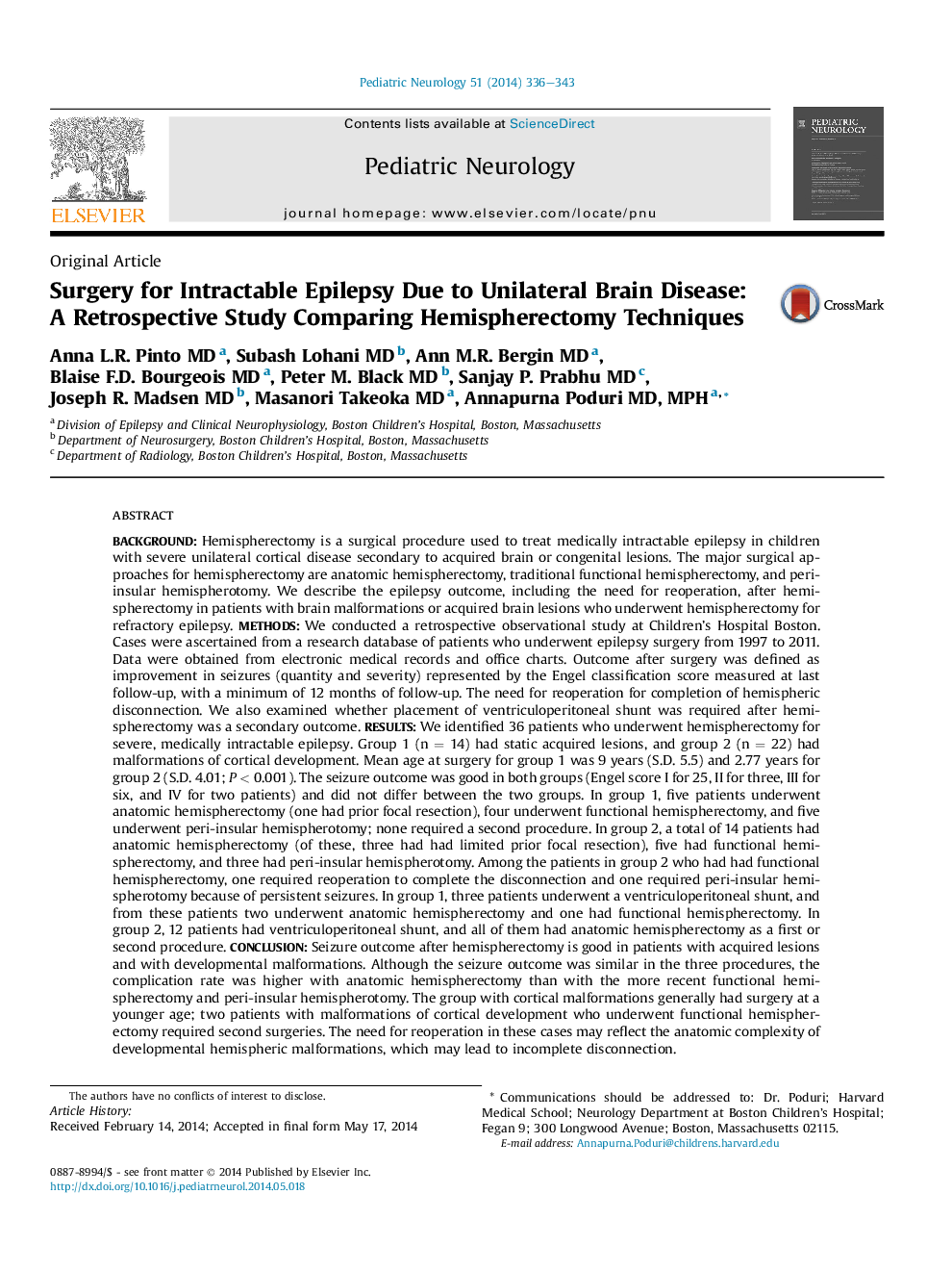| کد مقاله | کد نشریه | سال انتشار | مقاله انگلیسی | نسخه تمام متن |
|---|---|---|---|---|
| 3084619 | 1189775 | 2014 | 8 صفحه PDF | دانلود رایگان |
BackgroundHemispherectomy is a surgical procedure used to treat medically intractable epilepsy in children with severe unilateral cortical disease secondary to acquired brain or congenital lesions. The major surgical approaches for hemispherectomy are anatomic hemispherectomy, traditional functional hemispherectomy, and peri-insular hemispherotomy. We describe the epilepsy outcome, including the need for reoperation, after hemispherectomy in patients with brain malformations or acquired brain lesions who underwent hemispherectomy for refractory epilepsy.MethodsWe conducted a retrospective observational study at Children's Hospital Boston. Cases were ascertained from a research database of patients who underwent epilepsy surgery from 1997 to 2011. Data were obtained from electronic medical records and office charts. Outcome after surgery was defined as improvement in seizures (quantity and severity) represented by the Engel classification score measured at last follow-up, with a minimum of 12 months of follow-up. The need for reoperation for completion of hemispheric disconnection. We also examined whether placement of ventriculoperitoneal shunt was required after hemispherectomy was a secondary outcome.ResultsWe identified 36 patients who underwent hemispherectomy for severe, medically intractable epilepsy. Group 1 (n = 14) had static acquired lesions, and group 2 (n = 22) had malformations of cortical development. Mean age at surgery for group 1 was 9 years (S.D. 5.5) and 2.77 years for group 2 (S.D. 4.01; P < 0.001). The seizure outcome was good in both groups (Engel score I for 25, II for three, III for six, and IV for two patients) and did not differ between the two groups. In group 1, five patients underwent anatomic hemispherectomy (one had prior focal resection), four underwent functional hemispherectomy, and five underwent peri-insular hemispherotomy; none required a second procedure. In group 2, a total of 14 patients had anatomic hemispherectomy (of these, three had had limited prior focal resection), five had functional hemispherectomy, and three had peri-insular hemispherotomy. Among the patients in group 2 who had had functional hemispherectomy, one required reoperation to complete the disconnection and one required peri-insular hemispherotomy because of persistent seizures. In group 1, three patients underwent a ventriculoperitoneal shunt, and from these patients two underwent anatomic hemispherectomy and one had functional hemispherectomy. In group 2, 12 patients had ventriculoperitoneal shunt, and all of them had anatomic hemispherectomy as a first or second procedure.ConclusionSeizure outcome after hemispherectomy is good in patients with acquired lesions and with developmental malformations. Although the seizure outcome was similar in the three procedures, the complication rate was higher with anatomic hemispherectomy than with the more recent functional hemispherectomy and peri-insular hemispherotomy. The group with cortical malformations generally had surgery at a younger age; two patients with malformations of cortical development who underwent functional hemispherectomy required second surgeries. The need for reoperation in these cases may reflect the anatomic complexity of developmental hemispheric malformations, which may lead to incomplete disconnection.
Journal: Pediatric Neurology - Volume 51, Issue 3, September 2014, Pages 336–343
